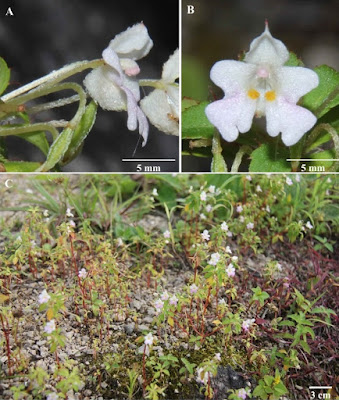[Most Recent Entries] [Calendar View]
Thursday, March 8th, 2018
| Time | Event | ||||||||
| 10:27a | [Botany • 2018] Three New Species of Impatiens (Balsaminaceae) from Myanmar; Impatiens decurva, I hartnolliae & I. oblongata
Abstract Three new species of Impatiens (Balsaminaceae) from Myanmar are here described: Impatiens decurva Ruchis. & S.B. Janssens, I. hartnolliae Hook. f. ex Ruchis. & Suksathan, and I. oblongata Ruchis. &Van der Niet. The 5-lobed short fusiform fruit of all three species suggests that they are members of subgen. Impatiens sect. Uniflorae Hook. f. & Thomson. For I. decurva and I. oblongata, subgenus membership was corroborated by phylogenetic analyses of a combined dataset of nuclear ITS and plastid atpB-rbcL intergenic spacer DNA sequences. This was not possible for I. hartnolliae, which is only known from a single herbarium specimen. Keywords: Impatiens, Myanmar, Southeast Asia, taxonomy, Uniflorae, Eudicots
1. Impatiens decurva Ruchis. & S.B. Janssens, sp. nov. Impatiens decurva Ruchis. & S.B. Janssens is similar to I. pendula B. Heyne ex Wight & Arn. (1834: 136) but differs in having congested leaves towards the stem apex, a pilose midrib on the dorsal petal, pink lateral united petals with a white base, an unequally bilobed apex of the lower lateral united petals, and a strongly decurved pedicel in fruiting stage. Distribution:— Endemic to Myanmar (Shan State). Ecology:— Growing in limestone soils on a mountain summit in open, fragmented evergreen forest, 1500–1600 m elevation. Etymology:— The specific epithet refers to the decurved pedicel at the early fruiting stage. Note:— Impatiens decurva Ruchis. & S.B. Janssens is the only spurless species in Myanmar with solitary flowers and spirally arranged leaves. Although it morphologically resembles I. pendula, I. decurva possesses a distinct characters: the leaves clustered towards the stem apex, a pilose midrib on the dorsal petal, the apex of the lower lateral united petals unequally bilobed, and a pedicel that is strongly decurved from the middle in the early fruiting stage. Impatiens decurva resembles I. muscicola Craib (1926: 162) in morphology. Impatiens muscicola is a species endemic to northern Thailand, and differs from I. decurva in having lower lateral petals with an unequally bilobed apex and a pedicel that is strongly decurved in the middle during the fruiting stage.
2. Impatiens hartnolliae Hook. f. ex Ruchis. & Suksathan, sp. nov. Impatiens hartnolliae Hook. f. ex Ruchis. & Suksathan is most similar to I. allanii Hook. f. (Ridley 1914: 325) but can be distinguished by its possession of a large orbicular sepal and large upper lateral petals. Distribution:— Endemic to Myanmar (Rakhine state). Ecology:— Growing in limestone soils. Etymology:— The specific epithet is derived from the collector name, H.S. Hartnoll. Notes:— Impatiens hartnolliae was written by J.D. Hooker on a single specimen sheet kept at Kew but was not validly published as according to Art. 30.1 (McNeill et al. 2012). To recognize Hooker’s work on Impatiens, we used the initial name provided by him to name this new species. The species can be easily distinguished from other species in having a racemose inflorescence, truncate lateral united petals, an emarginate dorsal petal, and a fusiform fruit. 
3. Impatiens oblongata Ruchis. & Van der Niet, sp. nov. Impatiens oblongata Ruchis. & Van der Niet is most similar to I. patula Craib (1926: 164) but can be distinguished by a distinctly shorter spur, broadly oblong upper lateral united petals with a truncate to slightly emarginated apex, and the apex of the lower lateral united petals truncate to slightly bilobed. Distribution:— Endemic to northeastern Myanmar (Shan State), where it is known only from the type locality. Ecology:— Growing in shady areas on a mountain summit in open fragmented evergreen forest, 1500–1600 m elevation. Etymology:— The specific epithet is derived from its broadly oblong upper lateral petals. Note:— This species usually has four lateral sepals, rarely two, in contrast to other similar species which have only two sepals, e.g., I. patula, I. violiflora Hook. f. (Hooker 1875: 457), I. curvipes Hook. f. (Hooker 1905: 25 & 32), and I. florulenta.  Saroj Ruchisansakun, Piyakaset Suksathan, Timotheüs van der Niet, Erik F. Smets, Saw Lwin and Steven B. Janssens. 2018. Three New Species of Impatiens (Balsaminaceae) from Myanmar. Phytotaxa. 388(1); 63–74. DOI: 10.11646/phytotaxa.338.1.5 | ||||||||
| 10:34a | [Herpetology • 2018] Ophisops pushkarensis & O. kutchensis • Two New Species of the Ophisops microlepis (Squamata: Lacertidae) Complex from northwestern India with A Key to Indian Ophisops
ABSTRACT We describe two new species of the lacertid genus Ophisops based on a series of 19 specimens from semi-arid habitats in the states of Gujarat and Rajasthan in northwestern India, provide a description of Ophisops microlepis sensu stricto, and a key to Indian Ophisops. Ophisops pushkarensis sp. nov. and Ophisops kutchensis sp. nov. are allied to Ophisops microlepis and can be diagnosed from all other Indian Ophisops by the fusion of the lower and upper eyelids, their large body size (snout to vent length > 50 mm), and ≥ 50 scales around midbody. They differ from O. microlepis and each other in the number of scales around midbody, the number of dorsal scales, subtle colour pattern differences, as well as uncorrected mitochondrial sequence divergence (6–9%). These are some of the only known endemic reptiles in these semi-arid landscapes and indicate that many other such habitats may harbour endemic biodiversity. KEYWORDS: Aravalli Range, cytochrome b, Eremiadinae, Kutch, tropic of cancer
Ophisops pushkarensis sp. nov. Pushkar small-scaled snake-eye Etymology. The name is for the type locality of the new species, Pushkar, in Rajasthan, India. Ophisops kutchensis sp. nov. Kutch small-scaled snake-eye Etymology. The name is for the type locality of the new species, in Kutch District, India. Ishan Agarwal, Akshay Khandekar, Uma Ramakrishnan, Raju Vyas and Varad B. Giri. 2018. Two New Species of the Ophisops microlepis (Squamata: Lacertidae) Complex from northwestern India with A Key to Indian Ophisops. Journal of Natural History. DOI: 10.1080/00222933.2018.1436203 |
| << Previous Day |
2018/03/08 [Calendar] |
Next Day >> |








